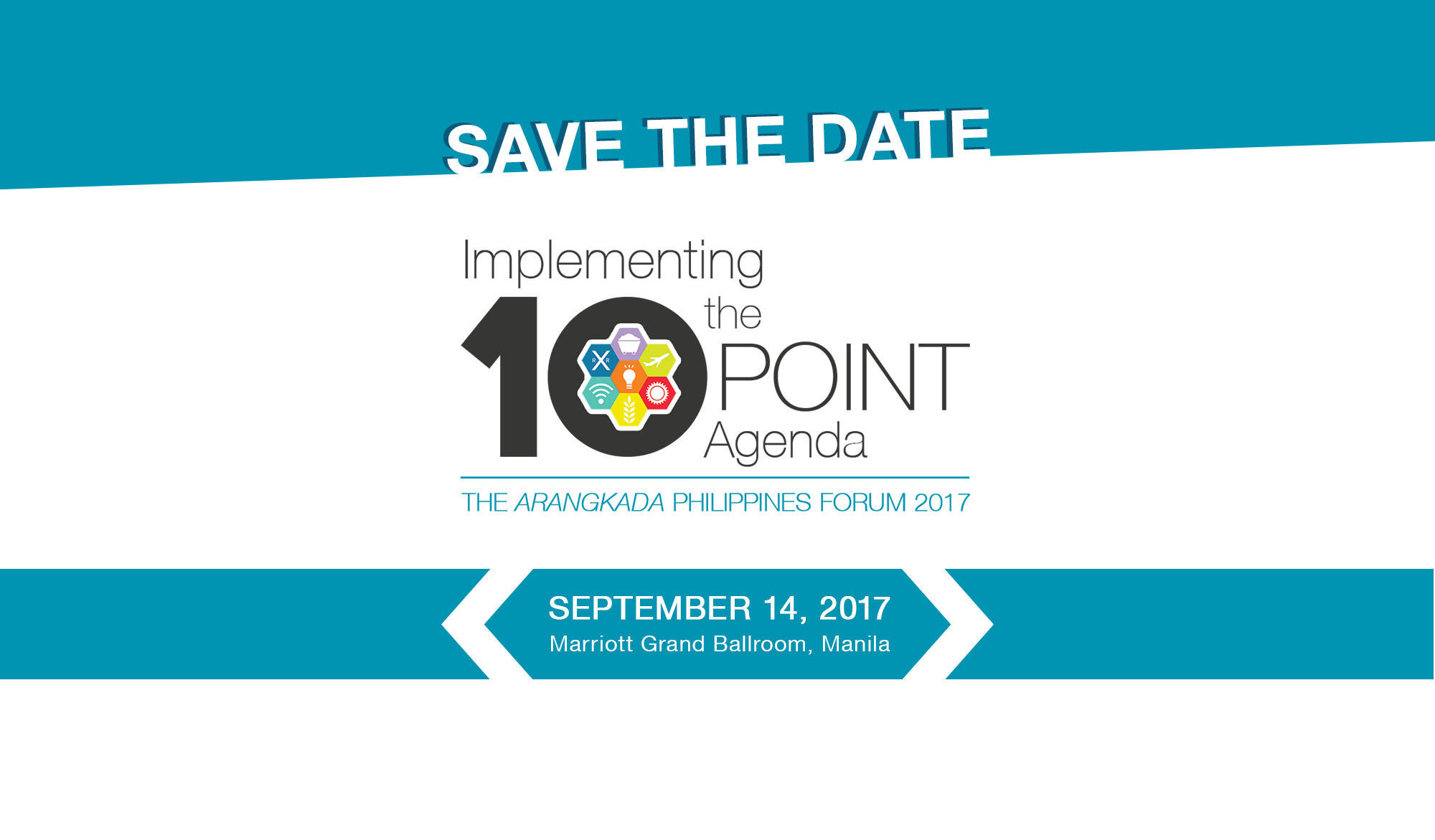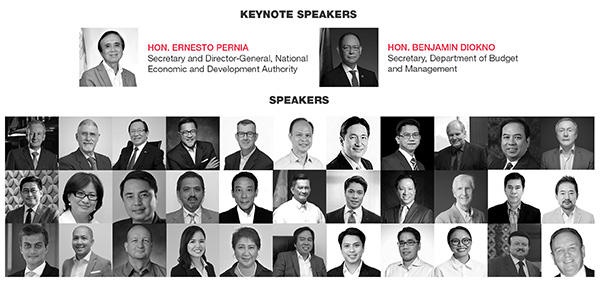Corporate Watch by Amelia H.C. Ylagan | September 18, 2017

Budget Secretary Benjamin Diokno and National Economic Development Authority (NEDA) Secretary Ernesto Pernia keynoted the Arangkada 2017 Forum on Sept. 14, when the Joint Foreign Chambers of Commerce and Filipino partners in business listened to economic opportunities in the near-, medium- and long-term.
“The Duterte administration will be different. We envision that by the time we step down in 2022, we would have ushered in the Golden Age of Infrastructure in the Philippines, an era that Filipinos will look back with affection as one that laid the necessary foundations for robust and equitable growth in the long-term,” Diokno said.
Sec. Diokno lamented the opportunities lost in the less than 2% of GDP of infrastructure spending from 1986 to 2016, which he said “reflected decades of neglect and misallocation of public resources.” He noted that “the suggested ratio for infrastructure spending as a share of GDP is 5% for developing countries.” Loud and clear, the “Build, build, build” program will reverse previous alleged “inaction” to high-gear “Spend, spend, spend” to stimulate economic development.
Sec. Pernia acknowledged past administrations’ accomplishments: “GDP growth has been on a sharp monotonic uptrend over the last three and a half decades. With a 6.9% GDP growth in 2016 — high end of the government’s target of 6% to 7% — the Philippines is poised to be one of the fastest rising economies in Asia over the medium-term.” Regarding the relative slowdown in the first two quarters of 2017 under Duterte, Pernia pointed out that this phenomenon seems normal, reflecting post-election-year effect on growth.
“The economy is also undergoing structural transformation — growth is increasingly being driven by investments vis-à-vis consumption, and is led by the industry sector relative to the service sector. In other words, sources of economic growth have broadened. Total factor productivity growth of the economy in recent years has been the fastest among ASEAN-6 countries at 3.3% for the period 2010-2014, and the highest in the group at 1.48% over the period 2010-2016” Pernia objectively said of the economic situation prior to “Dutertenomics.”
Pernia is confident that the economy is robust and sustainable, but he laments the inequality across households and regions, and the chronic poverty that persists amidst the glowing GDP numbers. “The country’s GDP remains concentrated in the Mega Urban-Industrial Region comprising the National Capital Region (Metro Manila), Calabarzon (Region 4A), and the Central Luzon Region (Region 3), which collectively accounted for nearly two-thirds of total GDP for the period. But the per capita income of NCR is almost triple the national average of P78,712 for 2016, while ARMM’s per capita income is now only 1/4 of the national average and 1/13th of NCR’s,” Pernia said.
“This is why we have identified infrastructure development as a priority of the Duterte administration,” Diokno emphasized. “We have to close the infrastructure gap soon if we are to realize our development objectives of becoming an upper-middle income economy by 2022 and reducing poverty rate to 14%. DBM is targeting at least 5% of GDP for infrastructure financing in the medium term; 5.4% for 2017; and 6.3% for 2018. In nominal terms, these figures translate to P858 billion and P1.1 trillion for FY 2017 and 2018, respectively.”
Diokno plans to finance this through an expansionary fiscal policy that first, increases the planned deficit from 2% to 3% of GDP. Second are the assumed increased revenues from the Tax Reform program. Combining the two expansionary measures, the government would generate an additional fiscal space amounting to P309 billion in 2018 and rising up to P524 billion in 2022, Diokno assumes.
But what if Diokno’s assumptions on revenue inflows do not actually happen? Would the brave swing to “Spend, spend, spend” from past “inaction” dent the “monotonic (boring?) uptrend of GDP” — the close to 7% GDP growth — acknowledged by Pernia?
The government will have to borrow more, that’s what it means.
Hopefully, the shortfall from unrealized revenues will not drive up long-term debt for future generations to pay for — we are still paying, until 2025, for the debts in Marcos’s martial law: “During the Marcos regime… many ‘successes’ were built on ‘debt-driven growth.’ While it is true that the regime embarked on an infrastructure spending spree, this was pursued largely to justify its existence and at the exorbitant cost of the ballooning of the country’s external debt (Rappler, 03.25.2016).”
And the spending of Marcos did not translate to higher GDP growth for him to brag about. “The economic setback due to the Marcos regime cemented our title as the ‘sick man of Asia’ for the good part of the past 3 decades, and prevented us from partaking of the so-called ‘East Asian miracle’ where by the time we recovered in 2003 the incomes of our neighbors had grown 2-4 times their 1982 levels (Ibid.).”
Many economists have warned that increased government spending does not necessarily stimulate GDP growth, and that the Keynesian recipe of “Spend, Spend, spend” (originally for the post-war economic rehabilitation) has lost flavor in the recent unpredictable, anti-cyclical booms and busts of financial and economic crises. Some even say that increased government spending can hamper economic growth, for the “crowding out” of the private sector, and for the politics that murk the decision factors for government intervention in economic planning.
Professor Emeritus of Law at George Mason University Gordon Tullock suggests that politicians and bureaucrats try to gain control of as much of the economy as possible. Demand for government resources by the private sector leads to misallocation of resources through “rent seeking” — the process by which industries and individuals lobby the government for money. Rather than spend money where it is most needed, legislators instead allocate money to favored groups. Though this may yield a high political return for incumbents seeking reelection, this process does not favor economic growth (mercatus.org, 06.10.2010).
A note to our present leaders and economic planners: Yes, we need roads and bridges, and other infrastructure. But when and if you decide to (over)spend on the “Build, build, build” hybrid PPP program, please be careful to study recent abundant analyses on the advantages and disadvantages of government spending as a stimulus to that much-desired GDP growth figure — make sure there is something to brag about in the end, as our economic history writes itself.
Amelia H. C. Ylagan is a Doctor of Business Administration from the University of the Philippines.

